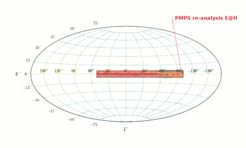Animation of the Pulsar Surveys

![This single 46'' (1.7 pc) beam, centered on the position of the Sgr A* radio source, is a targeted search for undiscovered pulsars orbiting the supermassive black hole candidate. These pulsars could enable the best tests of gravitational theories. The Galactic Centre (GC) search with the Effelsberg telescope started in January 2012, observing at a frequency of 18.95 GHz. Since then, the GC survey capabilities led to the first radio detection of a magnetar in the Galactic Centre likely less than half a light year from Sgr A* [Eatough et al., Nature, August 14, 2013].](/4046657/original-1625648884.jpg?t=eyJ3aWR0aCI6MjQ2LCJvYmpfaWQiOjQwNDY2NTd9--8f95f64a277a16a5fd1c339fe9aa271360daf488)
This single 46'' (1.7 pc) beam, centered on the position of the Sgr A* radio source, is a targeted search for undiscovered pulsars orbiting the supermassive black hole candidate. These pulsars could enable the best tests of gravitational theories. The Galactic Centre (GC) search with the Effelsberg telescope started in January 2012, observing at a frequency of 18.95 GHz. Since then, the GC survey capabilities led to the first radio detection of a magnetar in the Galactic Centre likely less than half a light year from Sgr A* [Eatough et al., Nature, August 14, 2013].

The Parkes Multi Beam Pulsar Survey (PMPS) was the most successful pulsar search to date. Re-analyses of the observational data are still producing new pulsar discoveries and results! One re-analysis project is currently conducted with EINSTEIN@HOME (E@H) (http://einstein.phys.uwm.edu/), a volunteer distributed computing project, designed to find pulsars in the most extreme binary systems.

The limit of the survey is 3.5°<|b|<5° and ~74°-150° in longitude. SPAN 512 („Survey Pulsar à Nançay”, http://arxiv.org/abs/1211.3936) started in January 2012 and was completed in June 2016. Observation was taken with the Nançay telescope in France at 1.2-1.7 GHz with a bandwidth of 512 MHz.

The ALFA pulsar survey (PALFA, http://www.naic.edu/alfa/pulsar/] started in 2004 and ended with the collapse of the Arecibo telescope in 2020. It was carried out with the Arecibo telescope that used the seven-pixel ALFA receiver recording data at 1.4 GHz. PALFA observes at low galactic latitudes in two survey regions 32°< l<77° and 168°<l<214°. PALFA began in 2004 and it was the most sensitive pulsar survey ever done until the appearance of FAST. To date, 208 new pulsars have been found in its data.

The Arecibo 327-MHz drift scan survey (http://www.naic.edu/~deneva/drift-search/) was an all-Sky survey, designed to cover the entire declination range visible with the Arecibo telescope (from -1° to +37° North) at a lower frequency, 327 MHz. Like the PALFA survey, it ended with the collapse of the Arecibo telescope in 2020. Until now, it has resulted in the discovery of 95 pulsars.

The LOFAR Tied-Array All-Sky Survey (LOTAAS, https://www.astron.nl/lotaas/index.php?sort=0&order=0) began in early December 2012 and ended in September 2019. Observations were taken with the LOFAR HBA Core Stations tied-array at observing frequency between 119-151 MHz. This survey has discovered 74 nearby, faint pulsars.

The High Time Resolution Universe (HTRU) survey is a blind survey of the northern sky with the 100-m Effelsberg radio telescope in Germany and a twin survey of the southern sky with the 64-m Parkes radio telescope in Australia. The survey is split into three regions of sky, the low-latitude, medium-latitude and high-latitude regions, with varying integration times for different discovery aims at each region.

All pulsar surveys as displayed in the animation at the top are displayed in Galactic coordinates centred at l=0°, b=0°.

![This single 46'' (1.7 pc) beam, centered on the position of the Sgr A* radio source, is a targeted search for undiscovered pulsars orbiting the supermassive black hole candidate. These pulsars could enable the best tests of gravitational theories. The Galactic Centre (GC) search with the Effelsberg telescope started in January 2012, observing at a frequency of 18.95 GHz. Since then, the GC survey capabilities led to the first radio detection of a magnetar in the Galactic Centre likely less than half a light year from Sgr A* [Eatough et al., Nature, August 14, 2013]. This single 46'' (1.7 pc) beam, centered on the position of the Sgr A* radio source, is a targeted search for undiscovered pulsars orbiting the supermassive black hole candidate. These pulsars could enable the best tests of gravitational theories. The Galactic Centre (GC) search with the Effelsberg telescope started in January 2012, observing at a frequency of 18.95 GHz. Since then, the GC survey capabilities led to the first radio detection of a magnetar in the Galactic Centre likely less than half a light year from Sgr A* [Eatough et al., Nature, August 14, 2013].](/4046657/original-1625648884.jpg?t=eyJ3aWR0aCI6MzQxLCJmaWxlX2V4dGVuc2lvbiI6ImpwZyIsIm9ial9pZCI6NDA0NjY1N30%3D--0d94f568c8713c0fed1ad96681973f881c72e0f9)






